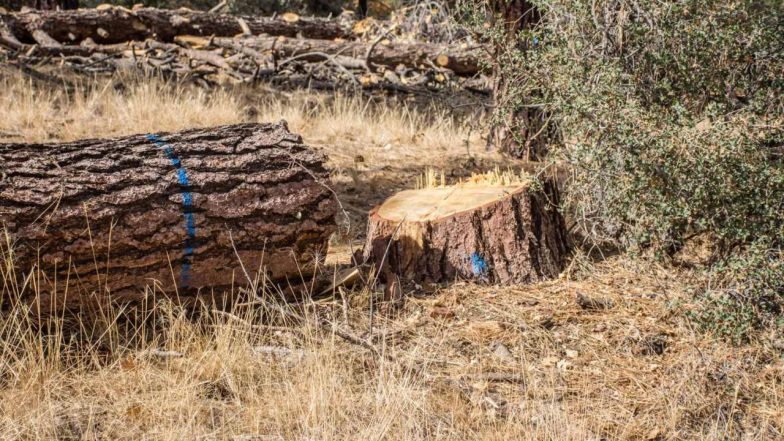Summary
Habitat loss is the reduction or elimination of the natural environments where plants and animals live and reproduce, primarily caused by human activities. It’s a major threat to biodiversity, leading to species endangerment and extinction. The three main types of habitat loss are destruction, degradation, and fragmentation.
OnAir Post: Habitat Loss
About
Source: Gemini AI Overview
Types of Habitat Loss
- Habitat DestructionThis is the complete removal or alteration of a habitat, making it unusable for the species that once lived there. Examples include deforestation, wetland draining, and urban development.
- Habitat DegradationThis involves the decline in habitat quality, making it less suitable for supporting life. Pollution, invasive species, and over-exploitation of resources can all contribute to degradation.
- Habitat FragmentationThis occurs when large, continuous habitats are broken into smaller, isolated patches, often by roads, agriculture, or other development. Fragmentation can hinder species movement, reduce genetic diversity, and increase the impact of edge effects.
Causes of Habitat Loss
- Human Population GrowthIncreased demand for resources like food, shelter, and space leads to habitat conversion for agriculture, urban expansion, and infrastructure development.
- AgricultureConversion of natural habitats, particularly forests and grasslands, for farming is a major driver of habitat loss.
- UrbanizationExpansion of cities and towns requires land, often displacing wildlife and fragmenting habitats.
- DeforestationThe clearing of forests for timber, agriculture, and other purposes reduces habitat for countless species.
- Resource ExtractionMining, drilling, and other forms of resource extraction can cause significant habitat destruction and pollution.
- Climate ChangeRising sea levels, changing weather patterns, and increased frequency of extreme weather events can alter habitats and make them unsuitable for certain species.
Problems
Habitat loss is a significant threat to global biodiversity, driven primarily by human activities and their impact on natural environments.
Initial Source for content: Gemini AI Overview 7/16/25
[Enter your questions, feedback & content (e.g. blog posts, Google Slide or Word docs, YouTube videos) on the key issues and challenges related to this post in the “Comment” section below. Post curators will review your comments & content and decide where and how to include it in this section.]
1. Land conversion for agriculture and development
- Expansion of agricultural lands for crops and livestock grazing is a primary driver of deforestation and habitat loss.
- Urbanization and infrastructure development (roads, cities, etc.) convert natural habitats into human-dominated landscapes, leading to habitat destruction and fragmentation.
2. Climate change
- Rising temperatures, altered precipitation patterns, rising sea levels, and increased frequency of extreme weather events directly degrade and destroy habitats.
- Examples include Arctic ice melt impacting polar bears and warmer water temperatures threatening coral reefs and cold-water fish species.
3. Resource extraction
- Logging, mining, and oil and gas exploration involve clearing vegetation, disturbing land, and polluting air and water resources, leading to extensive habitat degradation and loss.
4. Pollution and degradation
- Pollution from agriculture (pesticides, fertilizers), industrial activities, and waste contaminates soil, water, and air, making habitats unsuitable for native species.
- Runoff of excess nutrients from agricultural areas can create “dead zones” in aquatic ecosystems by reducing oxygen levels.
5. Habitat fragmentation
- Development, roads, and other barriers divide large, continuous habitats into smaller, isolated patches, disrupting wildlife movement and isolating populations.
- Small populations are more vulnerable to inbreeding, loss of genetic diversity, and extinction.
6. Invasive species
- Non-native species can outcompete native plants and animals for resources, introduce diseases, or prey upon native species, leading to population declines and ecosystem imbalances.
Research
Habitat loss is a major driver of biodiversity decline and ecosystem degradation. To combat this, research and innovation focus on restoring and protecting habitats, while also fostering sustainable practices that minimize human impact.
Initial Source for content: Gemini AI Overview 7/16/25
[Enter your questions, feedback & content (e.g. blog posts, Google Slide or Word docs, YouTube videos) on innovative research related to this post in the “Comment” section below. Post curators will review your comments & content and decide where and how to include it in this section.]
1. Nature-based solutions (NBS)
- Protecting and restoring natural ecosystems
This involves establishing protected areas, restoring degraded habitats like mangroves and forests, and creating wildlife corridors. - Sustainable land management
Practices like agroforestry, conservation agriculture, and integrated pest management aim to balance agricultural production with environmental conservation. - Water management
Techniques like biofiltration and smart irrigation improve water quality and optimize water use in restoration efforts.
2. Technological advancements
- Remote sensing and Geographic Information Systems (GIS)
These technologies are used to map, monitor, and manage restoration areas, providing insights into land cover changes, vegetation health, and water quality. - Drone technology
Drones gather high-resolution data, survey wildlife populations, map habitat destruction, and assist in reforestation by dispersing seeds. - Artificial intelligence (AI) and machine learning (ML)
AI algorithms analyze vast datasets to identify species, track populations, detect illegal wildlife trafficking, predict habitat changes, and optimize restoration planning. - Biotechnology
Genetic engineering and cloning are explored to enhance genetic diversity and resilience in endangered species, although ethical considerations are debated. - eDNA analysis
This technique detects the presence of species by analyzing DNA traces in environmental samples, providing valuable data for monitoring elusive species and guiding conservation planning.
3. Community-based approaches
- Citizen science
Engaging the public through apps and online platforms allows volunteers to contribute data on species sightings and environmental conditions, fostering a connection between people and nature. - Community involvement in restoration projects
NOAA’s Community-based Restoration Program, for instance, provides funding and support for projects that involve local communities in restoring coastal habitats, benefiting both wildlife and human well-being.
4. Addressing specific threats
- Mitigating climate change
Nature-based solutions, such as forestation, restoring peatlands, and managing wetlands, sequester carbon and enhance ecosystem resilience to climate change impacts. - Combating habitat fragmentation
Wildlife corridors help connect fragmented habitats, increasing species movement, genetic diversity, and resilience. - Combating soil degradation
Sustainable land management practices like conservation tillage, cover cropping, and crop rotation improve soil health and reduce erosion.
Solutions
Habitat loss is a major driver of biodiversity decline. Fortunately, numerous current and future projects are implementing solutions to this challenge.
Initial Source for content: Gemini AI Overview 7/16/25
[Enter your questions, feedback & content (e.g. blog posts, Google Slide or Word docs, YouTube videos) on current and future projects implementing solutions to this post challenges in the “Comment” section below. Post curators will review your comments & content and decide where and how to include it in this section.]
1. Habitat restoration and rewilding
- Reforestation and ecological restoration
Replanting forests, restoring degraded ecosystems, and rewilding efforts aim to restore natural habitats and increase biodiversity. For example, a forest restoration project in Mijares, Spain, is creating a more suitable environment for the endangered Iberian Lynx and its prey. - Coastal Habitat Restoration
Projects like those under the Infrastructure Investment and Jobs Act focus on restoring wetlands, estuaries, coral reefs, and large-scale bays and watersheds to protect marine life and coastal communities, according to NOAA Fisheries. - Dam Removal and Fish Passage
Projects like the removal of dams on the Pawcatuck River are restoring access to crucial spawning grounds for migratory fish such as American shad, alewife, and blueback herring. - Oyster Restoration
Projects in the Chesapeake Bay and North Carolina are creating oyster reefs to improve water quality, increase oyster spawning capacity, and provide habitat for fish species.
2. Wildlife corridors and connectivity
- Creating Wildlife Corridors
Efforts like the Yellowstone to Yukon Corridor are establishing corridors to connect fragmented habitats, allowing animals like grizzly bears and elk to migrate safely and access essential resources. - Fish Passage Improvements
The National Fish Passage Program focuses on removing barriers such as dams and restoring river ecosystems to improve fish passage and reconnect habitats.
3. Community engagement and conservation
- Community-based Restoration Projects
The NOAA Community-based Restoration Program supports projects that empower local communities to restore and conserve coastal habitats, leading to improved fisheries and recovering protected species. - Addressing Human-Wildlife Conflict
Initiatives like predator-proof chicken houses are helping communities in Nepal reduce retaliatory killing of fishing cats and decrease the need for poaching, benefiting both humans and wildlife.
4. Technology and innovation
- Remote Sensing and GIS
Drones, satellites, and GIS technology are used to monitor habitat changes, track deforestation, identify areas for restoration, and assess the effectiveness of conservation efforts. - Artificial Intelligence and Machine Learning
AI can be used to track and protect species, monitor ecosystems, and analyze data to inform conservation strategies. - Advanced Wildlife Tracking
Technologies like smart collars, remote cameras, and acoustic monitoring help researchers track wildlife movements, identify endangered species, and combat poaching and trafficking.
5. Policy and funding
- Endangered Species Act (ESA) and Habitat Conservation Plans (HCPs)
The ESA provides legal protections for endangered species and their habitats, while HCPs create partnerships between private landowners and government agencies to conserve species while allowing for development. - America the Beautiful Initiative
This initiative aims to restore, connect, and conserve 30 percent of lands and waters by 2030, with a focus on collaborative conservation efforts across the country. - Land and Water Conservation Fund (LWCF)
The LWCF provides funding for conservation programs, including land acquisition and easements to protect wildlife corridors and habitats. - Infrastructure Investment and Jobs Act
This act provides significant funding for habitat restoration and coastal resilience projects across the United States.


